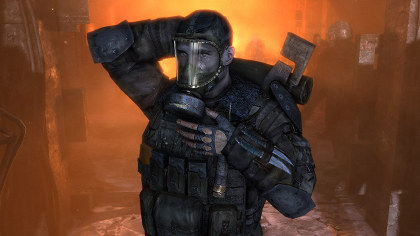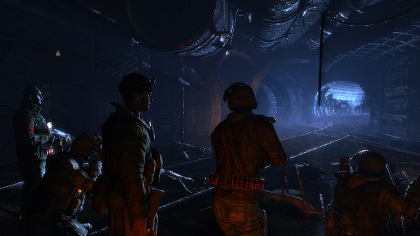If the sales charts are to be believed gamers are a pessimistic bunch. Apparently we like nothing more than winding down after the daily grind by transporting ourselves to post-apocalyptic wastelands fraught with mutants, radiation poisoning and the ultimate collapse of civilisation.
Developers ceaselessly realise our nightmares through the likes of Fallout, S.T.A.L.K.E.R and id’s forthcoming Rage, and even when the irradiated ideas well runs dry, they turn to literature for inspiration – in this case Russian author Dmitry A. Glukhovsky’s critically acclaimed 2002 novel, Metro 2033. Like their former colleagues at GSC Gameworld however, Ukrainian developers 4A Games hail from a culture distinctly and tragically informed by the horrors of nuclear fallout, imbuing Metro 2033 with a sobering tone even before picking up the controller.

These screens are taken from the eye-meltingly cutting-edge PC version. Unsurprisingly those are the only screenshots being circulated by the PRs.
Metro 2033 takes place in Russia’s eponymous underground metro system twenty years after an apocalyptic event blackened the skies and ravaged the world, nearly eradicating mankind and mutating what little life that remained into deadly malformed beasts, rendering the world’s surface uninhabitable. You fill the shoes of Artyom, a young man born in the final days before the apocalypse, but raised underground, trapped in a day-to-day struggle for survival in a harsh world populated by mutated monstrosities, warring factions of fellow humans and a mysterious emerging threat.
Rather than following the sandbox template popularised by its aforementioned post-apocalyptic stable mates, Metro 2033 is a tightly-focused and linear story-driven FPS, and given the game’s restrictive locale, the linearity is perhaps inevitable. Owing a debt to the Half-Life school of scripted narrative delivery, the vast majority of story sequences are witnessed from Artyom’s perspective, with 4A Games unwilling to break the connection between player and protagonist, even if they aren’t so hesitant to wrestle control away from the player as with Valve’s masterpiece.







 Satoru Iwata Video Interview - the late Nintendo president spoke with Kikizo in 2004 as 'Nintendo Revolution' loomed.
Satoru Iwata Video Interview - the late Nintendo president spoke with Kikizo in 2004 as 'Nintendo Revolution' loomed. Kaz Hirai Video Interview - the first of Kikizo's interviews with the man who went on to become global head of Sony.
Kaz Hirai Video Interview - the first of Kikizo's interviews with the man who went on to become global head of Sony. Ed Fries Video Interview - one of Xbox's founders discusses an epic journey from Excel to Xbox.
Ed Fries Video Interview - one of Xbox's founders discusses an epic journey from Excel to Xbox. Yu Suzuki, the Kikizo Interview - we spend time with one of gaming's most revered creators.
Yu Suzuki, the Kikizo Interview - we spend time with one of gaming's most revered creators. Tetris - The Making of an Icon: Alexey Pajitnov and Henk Rogers reveal the fascinating story behind Tetris
Tetris - The Making of an Icon: Alexey Pajitnov and Henk Rogers reveal the fascinating story behind Tetris Rare founders, Chris and Tim Stamper - their only interview? Genuinely 'rare' sit down with founders of the legendary studio.
Rare founders, Chris and Tim Stamper - their only interview? Genuinely 'rare' sit down with founders of the legendary studio. The History of First-Person Shooters - a retrospective, from Maze War to Modern Warfare
The History of First-Person Shooters - a retrospective, from Maze War to Modern Warfare